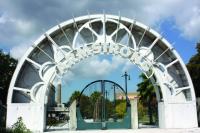
Jackson Square, New Orleans

Louis Armstrong Park, New Orleans
August 29, 2005, Katrina hit land and was the largest and third strongest hurricane in U. S. history with winds up to 175 mph and a storm surge of 20 feet. Eighty percent of New Orleans was flooded with as much as 20 feet of water in some neighborhoods. Almost two thousand people lost their lives in Louisiana and Mississippi and more than 700 people are still reported missing after nine years. Half of the reported deaths were senior citizens. Katrina remains the costliest hurricane in our history causing $81 billion in property damages alone. Most of the property damages and lives lost were a direct result of the levees breaching due to gross negligence of the U. S. Army Corps of Engineers and not the hurricane itself. That being said, please allow me to update you on recent Katrina related happenings in New Orleans in ‘14 and then I’ll finish this article with some hurricane preparation tips.
In the past month, the Army Corps of Engineers mailed 565,000 letters to individuals and businesses denying their claims for trillions of dollars of damages caused by the levee failures in ‘05. The one page letter stated, “The United States is immune from personal injury, property damage, and wrongful death claims resulting from the exercise or performance or the failure to exercise or perform a discretionary function or duty…The United States is also immune from damages from floodwaters…If you are dissatisfied with the denial of this claim, you may file suit in an appropriate United States Court no later than six months from the date of mailing this letter…failure to do so forever bars your claim.” U. S. District Court Judge Stanwood Duval states “… there has been no judicial relief for the hundreds of thousands of people and tens of thousands of businesses impacted… the Flood Control Act of 1928 as interpreted over the years gives the United States Army Corps of Engineers virtually absolute immunity, no matter how negligent it might have been in designing and overseeing the construction of the levees.” (see Mark Schleifstein’s 8/5/2014 article in the New Orleans’s Times-Picayune for further details.) Wow – what a blow to over half a million folks who survived the levee breach!
On a more positive note, today, 8/29/2014, there is a ribbon cutting ceremony for the opening of Delgado’s Sidney Collier campus in eastern New Orleans. This Community College was destroyed by Katrina and was just rebuilt nine years later using $21 million in federal and state funds. Eastern New Orleans is about the last area of the city to receive federal and state aid for rebuilding its neighborhoods, businesses and schools. Nine years is a mighty long time to wait for your college to reopen.
In other news this year concerning education in New Orleans, seven thousand tenured teachers who were laid off after Katrina won their appeal case and will receive two to three years of back pay. This ruling applies to teachers tenured at the time of Katrina who were wrongly terminated and had the right to be rehired as jobs opened up after the storm. Notices about the disaster leave without pay and then termination were sent to teachers’ pre-Katrina addresses even though many of the homes were destroyed by the storm. The March ‘06 termination letters advised dissatisfied teachers to appeal the layoff by coming to the School Board’s building which was also demolished by Katrina. Unbelievable, right? This happened even though the state-appointed consultants responsible had set up a hotline to collect evacuated teachers’ new addresses.
Nine years after Katrina, work has finally begun to repair the famous New Orleans’ Municipal Auditorium in Congo Square now known as Louis Armstrong Park. This beautiful landmark has played host to generations of graduations, thousands of internationally renowned performers and many decades of Carnival balls. Mayor Mitch Landrieu received $20 million from the Federal Emergency Management Agency and the initial phase of the restoration is expected to be complete in November 2015; three months after the 10th anniversary of Katrina. The lights were turned back on and gates to Louis Armstrong Park were finally unlocked and open to the public just two years ago. This year the Park reinstituted its Thursday night outdoor concerts; I so enjoyed the two I attended last spring and look forward to the time when I can attend concerts in the Municipal Auditorium!
The Dutch have worked with New Orleans planners to develop the “Greater New Orleans Urban Water Plan” to make the city better able to handle water runoff by working with instead of against water. The plan calls for retaining water in canals and ponds to keep land from drying out and sinking. Earlier this month, the National Association of Countries reported on the importance of this plan to help the city rebuild and protect its infrastructure after Katrina.
You may have read about the Henry Glover case where five police officers were accused of shooting Henry Glover and then New Orleans Police officer Gregory McRae set Glover and his car on fire to cover up the murder right after Katrina. The TV series Treme did a great job of bringing this case to national attention. All five policemen were found guilty several years ago, but the other four officers involved won their appeal due to lack of evidence because of the fire. McRae lost his appeal this month and will serve his 17 year sentence.
This month the Brookings Institute in DC issued a report stating Hurricane Katrina in ‘05 and the BP oil spill in ‘10 ranked as two of the top five “government failures” between 2001 and 2014. Researcher Paul Light used five categories to evaluate government failure. They are “lack of the right policy to deal with the problem, insufficient resources, the wrong structure or chain of command, lack of leadership by ‘top appointees’ and a culture that might have created confusing missions easily undermined.” Light said corruption and unethical conduct also played a role.
When we talk about how New Orleans has recovered nine years after Katrina, we must keep in mind that Caucasians and their neighborhoods have fared far better than the black community as I reported with shocking statistics last August in Coconut Times. Another thing to keep in mind when talking about the recovery is this – are we talking about the city and state or NOLA’s former residents who are still scattered across the country? I’d love to see good scientific research on all the folks who were never able to return to their homes and why.
As you can see from the recovery experiences nine years after Katrina, we need to take hurricane threats seriously in our area even though we do not have a levee system. Are we ready for a severe hurricane? If we’re hit by a big one, who will come to our assistance? Here are some tips to get through hurricane season:
• If the city calls for evacuation, GET OUT ASAP! Hope for the best and prepare for the worst.
• Fill your pantry with water jugs and plenty of can goods in case we lose electricity for several days and keep little in your refrigerator and freezer this time of year. Oh – have several flash lights and plenty of batteries.
• Make sure you are adequately insured.
• Video and make a list of your valuables and keep two sets of records in separate places. Your video and list will do you no good if it is lost in a flood! Also, back up your computer and keep a back up in a separate location.
• Have a “go list” of what goes in the car, what gets put in water proof containers and left behind, and what stays unprotected. Keep a suitcase packed with essentials in case you need to evacuate quickly.
We have learned many lessons from Katrina and its aftermath; let’s be prepared and hope we never have to apply them in our fair city by the sea.
«Go back to the previous page.